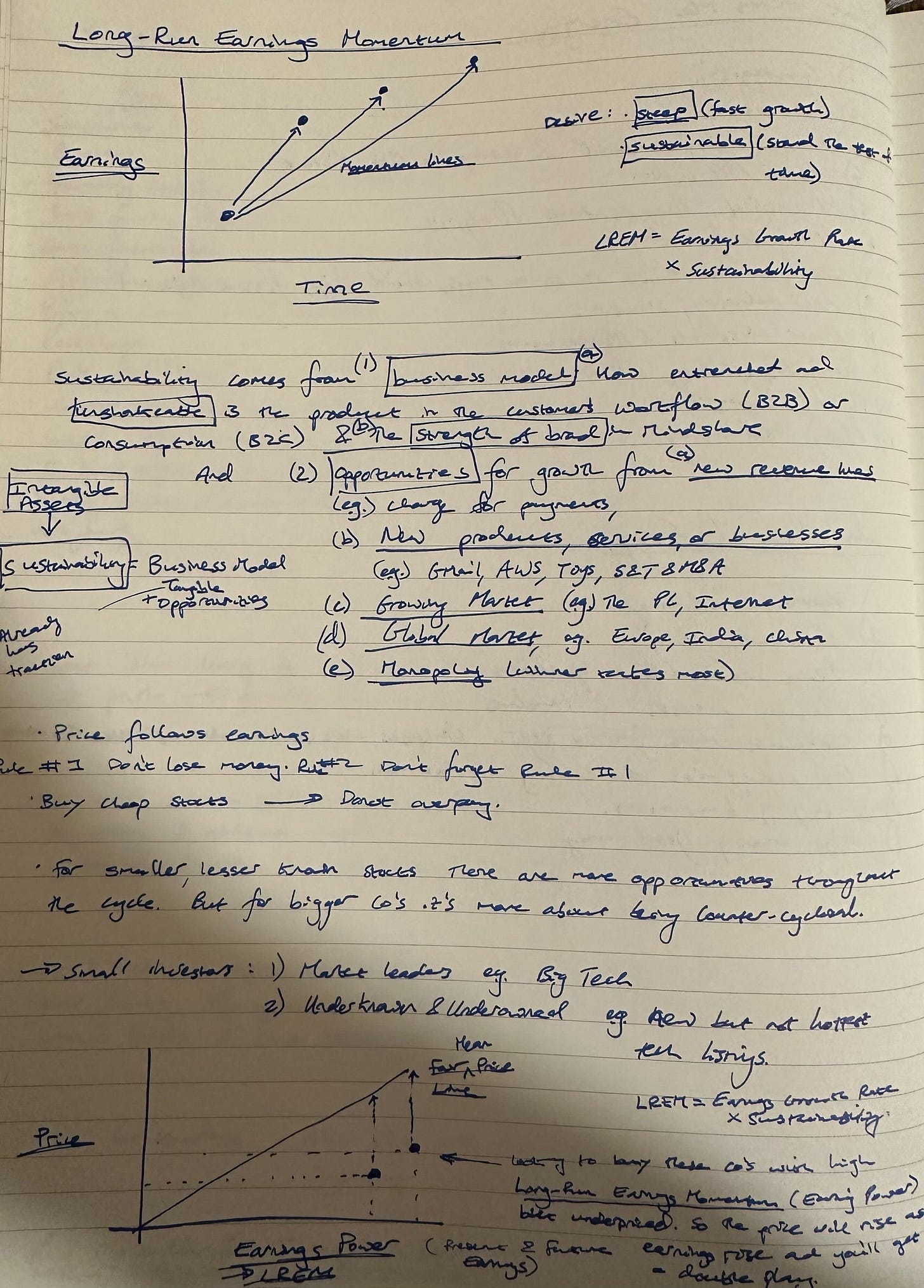The Mechanics of Stock Prices: How Earnings Momentum and Valuation Drive Returns
Uncover the forces behind stock price movements—steep, sustainable earnings growth and the gravitational pull of valuation multiples.
Prices Follow Earnings
When it comes to investing, the foundation is simple: prices follow earnings. To estimate future earnings, it’s essential to evaluate both tangible assets and intangible assets, as both contribute to the present value of a company’s future earnings. Intangible assets, in particular, often signal long-term earnings sustainability and opportunities for continued growth.
Understanding Earnings Momentum
In the accompanying diagram, we see how today’s earnings evolve over time to reach future levels, driven by Long-Run Earnings Momentum (LREM). The ideal momentum is both steep (indicating rapid growth) and sustainable (able to endure and thrive over time).
Sustainability is underpinned by two key factors:
The Business Model
Customer Entrenchment: How deeply integrated is the product in the customer’s workflow (B2B) or consumption habits (B2C)? This often requires direct conversations with customers to truly understand.
Brand Mindshare: How strong and enduring is the brand in the minds of its customers?
Opportunities for Growth
New Revenue Streams: Expanding into areas like payments or other services.
New Products or Businesses: Examples include Gmail, AWS, or entirely new verticals.
Market Growth: Leveraging industries with rapid expansion, such as the PC or internet markets.
Global Expansion: Entering large international markets like Europe, India, or China.
Monopolistic Advantage: Dominating a “winner-takes-most” market.
In essence, the key question is: Is this a big market, and can the company continue capturing a growing share of it?
Wisdom from Sequoia’s Don Valentine
“We have always focused on the market: the size of the market, the dynamics of the market, because our objective was to build big companies. If you don’t attack a big market, its highly unlikely you’re ever going to build a big company… Magnitude of the problem they’re solving, and what in fact can happen if they’re correct” - Don Valentine, Sequoia
“There are two things in business that matter, and you can learn this in two minutes—you don’t have to go to business school for two years: high gross margins and cash flow. The other financial metrics you can forget.” - Don Valentine, Sequoia
Calculating Long-Run Earnings Momentum
LREM can be expressed as:
Earnings Growth Rate × Earnings Growth Rate Sustainability
The Importance of Valuation
A critical aspect of successful investing is to not overpay. The goal is to find opportunities where the company’s earnings power isn’t fully reflected in its current valuation. In such cases, two forces work in your favor:
Valuation Gravity: The stock’s valuation multiple rises over time to reflect its true earnings potential.
Earnings Growth: Sustained high earnings power ensures continued growth in profits.
This combination creates a “double play”: valuation expansion paired with rising earnings.
A Useful Metric:
(Gross Profit × 1/Growth Rate) ÷ Price
This metric highlights opportunities where earnings power is both high and sustainable, and valuation has room to grow.
Beyond the Mean: Understanding Market Dynamics
Valuation multiples can exceed their historical mean for quality stocks due to:
Price Momentum: Rising prices attract more attention, creating a self-reinforcing cycle.
Institutional Demand: Quality stocks are perceived as safer bets, which institutional investors are willing to pay a premium for.
Retail Crowding: Retail investors tend to focus on a small set of well-known stocks, driving up demand.
This crowding effect can push valuations beyond the mean in a nonlinear fashion. For this reason, don’t sell just because a stock’s price seems “fair.” Instead, evaluate it against industry comps, including growth rates, market opportunity, quality, dominance, and narrative enthusiasm. Sell only when the valuation reflects the status of other “market favorites.”





